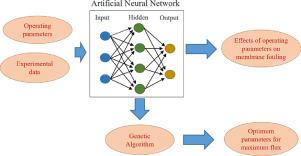Chemical Engineering and Processing: Process Intensification ( IF 3.8 ) Pub Date : 2021-04-01 , DOI: 10.1016/j.cep.2021.108403 Srishti Mittal , Aniket Gupta , Saksham Srivastava , Manish Jain

|
Vacuum membrane distillation is a novel separation process that requires less energy and provides high selectivity. However, membrane fouling is a severe issue in the commercialization of this process. One of the methods to minimize membrane fouling is the use of appropriate operating conditions. In this study, an Artificial Neural Network (ANN) based approach is used to model the vacuum membrane distillation process and analyze the effects of operating parameters on membrane fouling. An ANN was developed through MATLAB's Deep Learning Toolbox. First, the number of nodes in the hidden layer was optimized. The minimum value of mean square error (0.58) was achieved with ten nodes. The model predictions were successfully validated with a correlation coefficient of more than 0.98. The trained ANN was then used to analyze the effects of operating conditions on flux and membrane fouling. High membrane fouling was observed at high feed temperature and vacuum tightness. Higher feed solute concentrations were also responsible for high membrane fouling. In the optimization study, high feed temperature and moderate to high vacuum tightness for lower solute concentration; and high feed temperature and low to moderate vacuum tightness for higher solute concentration were found optimum operating conditions to achieve maximum fluxes.
中文翻译:

基于人工神经网络的真空膜蒸馏过程建模:操作参数对膜污染的影响
真空膜蒸馏是一种新颖的分离工艺,需要较少的能量并具有较高的选择性。然而,在该方法的商业化中,膜结垢是一个严重的问题。最小化膜污染的方法之一是使用适当的操作条件。在这项研究中,基于人工神经网络(ANN)的方法用于对真空膜蒸馏过程进行建模,并分析操作参数对膜污染的影响。ANN是通过MATLAB的深度学习工具箱开发的。首先,对隐藏层中的节点数进行了优化。十个节点实现了均方误差的最小值(0.58)。模型预测已成功验证,相关系数大于0.98。然后将训练有素的人工神经网络用于分析操作条件对通量和膜污染的影响。在高进料温度和真空密封性下观察到较高的膜污染。较高的进料溶质浓度也是造成膜污染的原因。在优化研究中,较高的进料温度和中等至较高的真空密封性可降低溶质浓度;发现较高的进料温度和较低至中等的真空密封性以实现更高的溶质浓度,以实现最大通量的最佳操作条件。高进料温度和中等至高真空密封性,以降低溶质浓度;发现较高的进料温度和较低至中等的真空密封性以实现更高的溶质浓度,以实现最大通量的最佳操作条件。高进料温度和中等至高真空密封性,以降低溶质浓度;发现较高的进料温度和较低至中等的真空密封性以实现更高的溶质浓度,以实现最大通量的最佳操作条件。











































 京公网安备 11010802027423号
京公网安备 11010802027423号